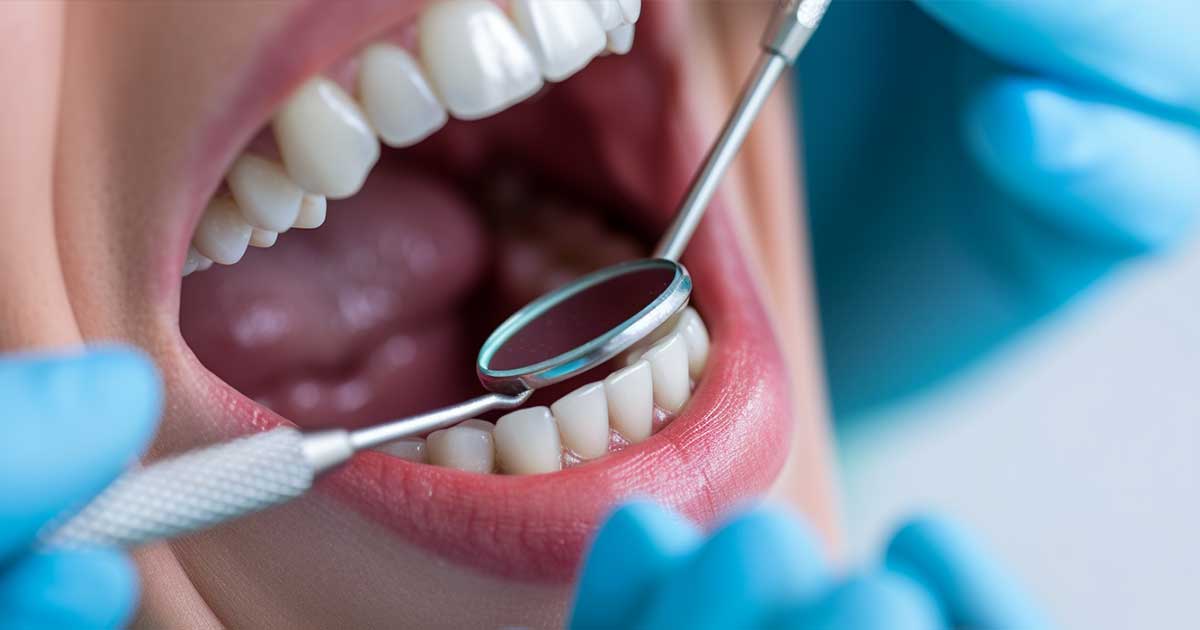TL;DR Regular check-ups with a dentist seems crucial for maintaining optimal oral health. They help detect and address issues early, preventing the progression of conditions like gum disease and cavities.
Importance of oral health and gum disease prevention
Maintaining optimal oral health is pivotal to overall well-being, emphasizing the importance of preventive measures against gum disease. By adhering to diligent oral hygiene practices, attending regular dental check-ups, and embracing a balanced diet, individuals fortify their defenses against the perils of gum disease.
Upholding Oral Health Through Proactive Measures
Consistent oral hygiene practices, including brushing twice daily with fluoride toothpaste, flossing, and using mouthwash, foster an environment hostile to bacterial growth. These habits mitigate the accumulation of plaque and tartar, key contributors to gum disease development.
Regular dental check-ups represent an indispensable component of preventive dental care. Dentists perform thorough examinations, deep cleanings, and provide personalized guidance on maintaining oral hygiene at home.
A well-rounded approach to oral health encompasses dietary choices. A balanced diet rich in fruits, vegetables, lean proteins, and whole grains promotes gum health and bolsters the body's ability to combat infections. Limiting the consumption of sugary snacks, sugary foods and acidic beverages diminishes the risk of enamel erosion and gum inflammation.
Understanding the Ramifications of Gum Disease
Gum disease, if left unchecked, can exert far-reaching consequences on both oral and systemic health. The initial stage, gingivitis, manifests as red, swollen gums prone to bleeding during brushing or flossing. Without intervention, gingivitis may progress into periodontitis, a more severe form of gum disease characterized by gum recession, tooth mobility, and potential tooth loss.
The implications of untreated gum disease extend beyond the confines of the oral cavity. Research suggests a correlation between periodontal disease and systemic conditions such as cardiovascular disease, diabetes, and respiratory infections. Inflammation stemming from gum disease can exacerbate existing health issues, underscoring the interconnectedness of oral and overall health.
Embracing the Benefits of Gum Disease Treatment
Actively addressing gum disease yields multifaceted benefits. Professional interventions, including scaling and root planing, aim to eradicate bacterial deposits and restore gum health. Additionally, adjunctive therapies such as antibiotics or surgical interventions may be prescribed based on the severity of the condition.
By prioritizing gum disease treatment, individuals safeguard their oral structures against irreversible damage. Restoring gum health enhances oral function, preserves natural dentition, and revitalizes one's smile aesthetics.
Gum Disease Unveiled: Understanding, Causes, and Stages
Gum disease, or periodontal disease, presents a substantial challenge to oral health. This section aims to offer a concise overview of the disease's definition and causative factors, enabling readers to comprehend its origins.
Recognizing early signs, such as bleeding or swollen gums, bad breath, and tooth misalignment, empowers individuals to intervene.
Definition and causes of gum disease
It represents a spectrum of conditions affecting the tissues surrounding and supporting the teeth. It manifests primarily in two stages: gingivitis and periodontitis. Gingivitis, the initial phase, involves inflammation of the gums, while periodontitis signifies a more advanced condition, characterized by damage to the bone and fibers supporting healthy teeth.
The Culprit - Plaque Buildup
The primary driver behind gum disease is the accumulation of plaque—a soft, sticky film of bacteria that forms on teeth. If not diligently removed through regular oral hygiene practices, plaque can evolve into a catalyst for gum disease, creating an environment conducive to inflammation.
Causes and Contributing Factors
- Insufficient Oral Hygiene: One of the foremost contributors to gum disease is insufficient oral hygiene. Neglecting regular brushing and flossing provides an opportunity for plaque to thrive, leading to inflammation of the gums and initiating the development of gum disease.
- Medications and Dry Mouth: Certain medications contribute to dry mouth, diminishing the natural cleansing action of saliva and increasing susceptibility to dental plaque buildup. This underscores the importance of considering medication side effects in oral health management.
- Tobacco Use: The detrimental impact of smoking and chewing tobacco on oral health is significant. Beyond compromising the immune system, tobacco use impedes the healing capacity of gum tissues, heightening the risk and severity of gum disease.
- Systemic Conditions: Diabetes: Individuals with diabetes face an elevated risk of gum disease. Impaired blood flow to the gums, coupled with a compromised immune response, makes diabetic individuals more prone to bacterial attacks and challenges in combatting gum infections.
Recognizing the Factors for Prevention
By emphasizing proper oral hygiene, addressing medication-related concerns, and promoting lifestyle changes such as quitting tobacco, individuals can significantly mitigate the risk of gum disease and maintain optimal oral health.
Stages of gum disease
Let's go through the stages of gum disease, shedding light on the early indicators, potential causes, and key risk factors associated with each phase.
Stage 1: Gingivitis
- Signs and Symptoms: Gingivitis manifests as red, swollen gums that may bleed during brushing or flossing. Persistent bad breath is also common.
- Potential Causes: Poor oral hygiene is a primary cause, allowing plaque—a sticky film of bacteria—to accumulate along the gumline.
- Key Risk Factors: Smoking, diabetes, and hormonal changes increase the risk of gingivitis.
Stage 2: Early Periodontitis
- Signs and Symptoms: As gum disease progresses, pockets may form between the teeth and gums. Gums may recede, causing tooth sensitivity and a change in the way teeth fit together.
- Potential Causes: Untreated gingivitis leads to the buildup of tartar, a hardened form of plaque, exacerbating inflammation.
- Key Risk Factors: Genetics, poor nutrition, and certain medications contribute to the development of early periodontitis.
Stage 3: Moderate Periodontitis
- Signs and Symptoms: Increased pocket depth, noticeable gum recession, and potential pus formation characterize this stage. Teeth may become loose, affecting bite and overall oral function.
- Potential Causes: Continuing inflammation damages the supporting structures of the teeth, including bone and connective tissue.
- Key Risk Factors: Smoking, stress, and systemic diseases such as heart disease can escalate periodontal damage requiering periodontal treatment and
Stage 4: Advanced Periodontitis
- Signs and Symptoms: Severe gum recession, significant tooth mobility, and potential tooth loss define advanced periodontitis. Infection may extend to the bone, leading to abscess formation.
- Potential Causes: Long-term neglect of earlier stages results in irreversible damage to the bone and surrounding tissues.
- Key Risk Factors: Chronic medical conditions like rheumatoid arthritis and a compromised immune system heighten the risk of advanced periodontitis.
Symptoms and Consequences of Gum Disease
Understanding the symptoms is crucial for early intervention. Persistent bad breath, inflamed or bleeding gums, and tooth sensitivity are indicative of gum disease. Neglecting these warning signs may lead to severe consequences, including tooth loss and compromised overall health.
Beyond the oral cavity, research suggests a link between gum disease and various systemic health issues, such as heart disease. This connection underscores the importance of addressing gum disease promptly.
Recognizing the signs and comprehending the broader impact is essential for those seeking to manage and mitigate the effects of gum disease without professional dental intervention.
Recognizing the signs of gum disease
Timely recognition of symptoms plays a pivotal role in preventing the progression of this medical condition. Understanding and identifying the indicators can empower individuals to take proactive steps towards maintaining optimal oral health.
Common Symptoms of Gum Disease
One of the primary symptoms indicative of gum disease is bleeding gums. While occasional bleeding during brushing or flossing may be dismissed, persistent or excessive bleeding should not be ignored. This often occurs due to the inflammation of the gums, a characteristic feature of gum disease.
Receding gums, another sign of concern, involve the gums pulling away from the teeth, creating pockets where harmful bacteria can thrive. This can lead to tooth sensitivity and, if left unaddressed, may contribute to tooth loss.
Persistent bad breath, medically known as halitosis, is a subtle yet significant symptom of gum disease. The bacteria that cause gum disease release toxins, resulting in an unpleasant odor. Individuals experiencing chronic bad breath should consider it a potential signal of underlying gum issues.
Importance of Recognizing Signs for Early Intervention
Early-stage gum disease, known as gingivitis, is reversible with proper oral care. Neglecting these warning signs may allow the condition to progress into more advanced stages, such as periodontitis, which can lead to irreversible damage, including bone loss and tooth mobility.
How to Recognize the Signs
To identify the signs of gum disease, regular self-examinations are crucial. Observing changes in gum color, swelling, or texture can be indicative of underlying issues. Individuals should also pay attention to changes in the way their teeth fit together when biting and be alert to any discomfort or extreme pain while chewing.
Link between gum disease and other health issues (e.g., heart disease)
The ramifications of advanced gum disease extend beyond the confines of oral health, with emerging evidence suggesting a potential link between gum disease and various systemic health issues, particularly cardiovascular diseases. This connection underscores the importance of addressing gum disease not only for the sake of oral hygiene but also for overall well-being.
Impact on Cardiovascular Health
Research has illuminated a correlation between gum disease and an increased risk of cardiovascular issues, such as heart disease and stroke. The mechanisms underlying this connection are multifaceted, involving both direct and indirect pathways.
- Arterial Damage and Cardiovascular Disease: Gum disease, characterized by inflammation and bacterial infection, has been implicated in contributing to the deterioration of arterial health. The inflammatory response triggered by oral infections may extend beyond the gums, affecting the entire circulatory system. This inflammatory burden can lead to the narrowing and stiffening of arteries, a condition known as atherosclerosis. Over time, this process may escalate the risk of cardiovascular diseases.
- Exacerbation of Existing Heart Disease:Individuals with pre-existing heart conditions may face exacerbated risks when gum disease enters the equation. The inflammatory nature of gum disease can intensify the burden on the cardiovascular system, potentially complicating the management of existing heart conditions. Effective management of gum disease becomes paramount in preventing additional stress on the heart.
- Increased Stroke Risk from Blocked Vessels:Blocked vessels, a consequence of atherosclerosis linked to gum disease, pose a significant risk of stroke. The formation of blood clots in vessels compromised by inflammation can impede blood flow to the brain, leading to a heightened risk of stroke. Understanding and addressing the link between gum disease and stroke is crucial for individuals seeking to safeguard their cardiovascular health.
Oral Infections and Systemic Health
Beyond the cardiovascular system, gum disease has been associated with various other health issues due to the spread of oral infections throughout the body. These infections can act as a catalyst for systemic inflammation, impacting overall health.
- Oral Infections and Systemic Inflammation: Gum disease serves as a potential source of chronic inflammation, with harmful bacteria entering the bloodstream and disseminating throughout the body. This systemic inflammation has been linked to conditions such as diabetes, respiratory diseases, and rheumatoid arthritis. Managing gum disease becomes a proactive measure in preventing the escalation of inflammatory responses.
- Association with Other Diseases: Research has also explored connections between gum disease and conditions such as endocarditis, a rare but serious infection of the heart's inner lining. Additionally, there is ongoing investigation into links with certain respiratory diseases, emphasizing the intricate interplay between oral health and systemic well-being.





Share:
Why do my gums bleed when i brush my teeth?
How Long Can You Expect a Tooth Crown to Last?